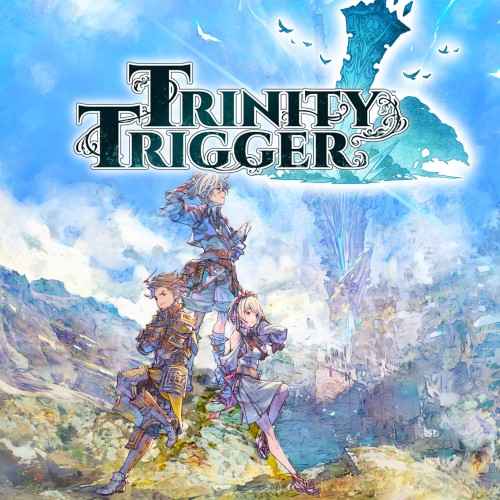Trinity Trigger Review
Late last year I got to review Square-Enix’s action JRPG Harvestella. In that review, I wrote that it felt like it was continuing the legacy of the Mana series. Well if you’re Mana fan, Trinity Trigger is essentially one big tree away from being named “Trigger of Mana” or “Secret of Mana 3”. It’s an action JRPG featuring a creative team of designers from Secret of Mana and Xenoblade, a writer from Octopath Traveler, and the composer of Secret of Mana. Trinity Trigger is JRPG comfort food. If you’re a fan of Super Nintendo era action JRPGs, then Trinity Trigger is a must-play.
The world of Trinity Trigger is a unique one. There is an ancient war being waged between gods of chaos and order. This war causes skyscraper-sized weapons to fall from the sky. The game’s protagonist, Cyan, lives in a town at the base of one of these massive weapons (in this case a buster-like sword). Cyan is adopted and doesn’t remember his past. He also has a mysterious glowing eye, that’s been getting more noticeable as of the beginning of the game.
Early in the game, Cyan befriends Flamme, who is a little Japanese freak creature that transforms into different weapons. It has no knowledge of its past either, but feels a connection to Cyan’s glowing eye. I don’t want to spoil much of the narrative, as it really drives the game forwards, but early on Cyan meets Elise, who has her own Japanese freak creature, and tells him there are people after him, trying to kill him. That was the point where I was hooked.
Can One Ever Have Too Many Classic JRPG Tropes?
Some may find the narrative has too many classic JRPG tropes. The war against gods and an amnesiac protagonist are very common among classics from the genre. But that’s kind of what the whole game is like. There are little bits of modernisms here and there, but the entire package is a throwback, and some will find parts of it archaic.
This is the kind of game where you walk around a town, barge into people’s houses, gather info, and buy fresh gear. Then you cross a patch of land, descend into a dungeon, fight a boss, and get some more story beats. Rinse and repeat. This is intended, and for lovers of classic JRPGs, it mostly feels great. There are little things that could have been streamlined, like just triggering an auto-save/ heal by stepping onto a save point, instead of going into a menu and having to select both actions separately. But these are such minor inconveniences.
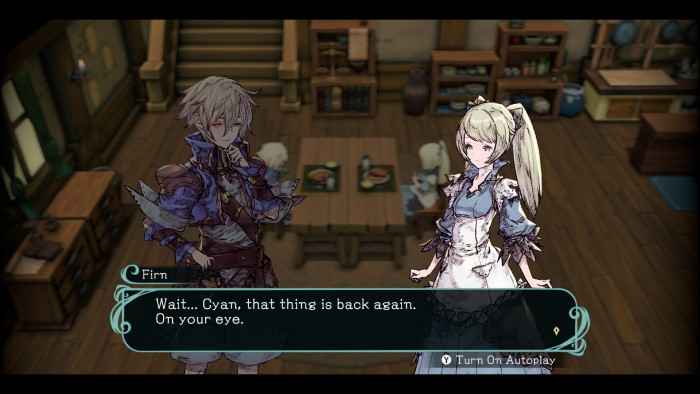
The combat is where the Secret of Mana influence really shows. The player controls three characters, and can switch between them at any time. Once all three characters are unlocked, there’s also an option for 3 player local co-op! Combat is real-time, not turn-based. The Secret of Mana attack gauge is back. Characters quickly deplete their stamina, and have to wait for it to build between combos. Each character has a three-hit combo attack, and each attack in the combo has several options. For example, a less powerful attack could be chosen that also offers minor healing with each successful strike. Circle executes a dodge roll, which, if done with perfect timing, restores the attack gauge.
Deep, Fun Combat
There are different types of melee weapons, which enemies have strengths and weaknesses to. Each weapon type has an aura, which is a different ability, such as a temporary buff, assigned to the square button. Aura’s have a gauge that slowly fills when landing attacks. Over time, weapons glow and triangle can be pressed to activate a more powerful attack called a trigger strike. They’re kind of like a saveable limit break. Bosses have an armor gauge that has to be depleted before dealing damage to their health. When armor is destroyed, they enter a short, easily attackable period. Basic strategy is to whittle down armor with normal attacks, then save auras and trigger attacks for this period.
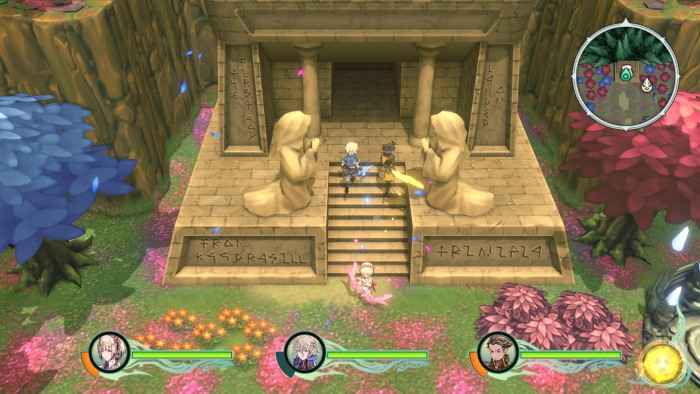
It’s fun to assign the three characters different melee weapons, then switch between them at any time by pressing the L2 and R2 buttons. There’s a lot of variety, with swords feeling very different from bows, etc. The item wheels from Secret of Mana also appear in Trinity Trigger. The full menu can be accessed at any time, but it was nice to have the option for quick use of healing items, and quick switching of melee weapons to keep combat flowing. When playing single player, the player controls one character and the others auto-attack. My only complaint about combat is I found my AI-controlled characters dying pretty easily. They’re smart about attacking, but not about their self-preservation. The player can activate auto-potions, but I hated how my support characters ran through them.
Not Perfect
One of my only major complaints about Trinity Trigger is that the dungeon designs are a little bland. There’s an emphasis on finding materials. These can be used to craft items for a greatly reduced cost. The dungeon design hook is that there are lots of breakable walls and hard to see secret areas with hidden chests. But these don’t take any clever puzzle solving to overcome. The field areas between towns are interesting and diverse, but every single dungeon is a similar looking temple ruin. The combination of similar looks, and basic treasure hunting are a bit of a letdown considering how great the combat and narrative are.
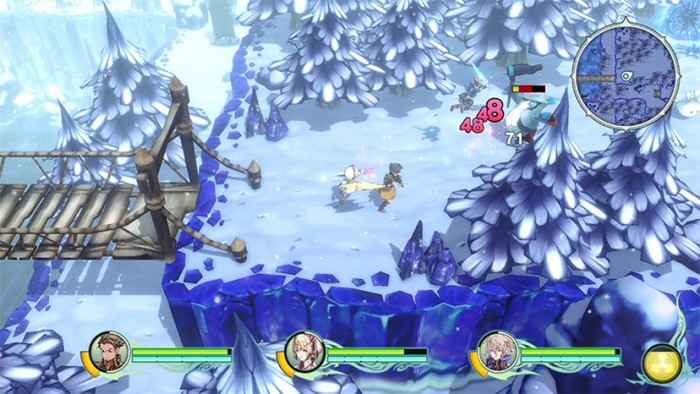
The graphics are a mixed bag. At first, I thought Trinity Trigger kind of looked like a PS2 era JRPG like Radiata Stories. The insides of houses have lots of bookshelves, pots, and baskets of things. There’s a cell-shaded texture over everything that masks the ugly polygons. It’s obviously a budget title. But the top-down perspective and chibi art style make Trinity Trigger look similar to modern handheld JRPGS like Bravely Default and Alliance Alive. It looks fine, but definitely isn’t my favorite aesthetic. I would choose 16-bit pixels any day for this style of JRPG throwback. There are also gorgeous anime cutscenes peppered throughout the game, but strangely there’s no long intro movie set to song.
Puberty Confusion
The sound is also a bit of a mixed bag. The score is lovely. There’s no super memorable JRPG banger tracks, but there’s a medieval fantasy vibe mixed with chill prog rock that I really enjoyed. The voice acting is pretty good for the most part. Cyan is horribly miscast though. The Cyan chibi model looks an 8-year-old. The character art ages him a bit, making him look maybe 13 years old. But the voice actor sounds like he’s 35, and it was jarring at first. That being said, there is full English voice acting, and the option to switch to Japanese. Most main character conversations are fully voiced, with most NPCs just having a “hello” or “hahaha” when talking.
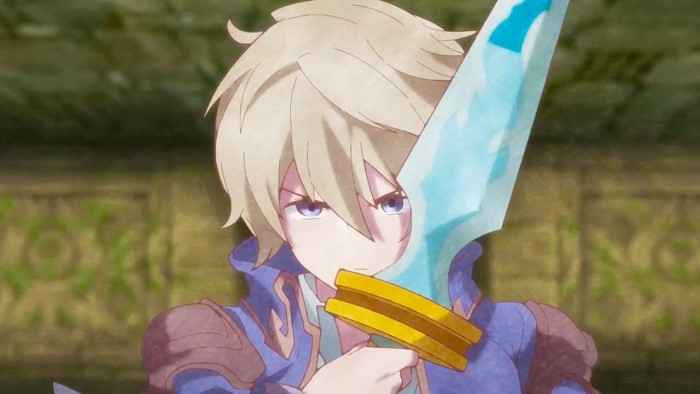
I loved Trinity Trigger. I’m a big fan of JRPGs, and the Mana series though. This is a game for fans of the genre. Its bland dungeon design and sometimes dumb support character AI hold it back from being a full-blown genre classic. But it has a compelling narrative and great combat. And the local co-op option seems too good to be true in this day and age. If you’re not into action JRPGs, Trinity Trigger isn’t going to change your mind. But anyone with any love for the genre should definitely give it a playthrough.
***PS5 code provided by the publisher***
The Good
- Local co-op
- Fun combat
- Celebration of SNES era JRPGs
The Bad
- Poor support character self-preservation
- Bland dungeon design
- By the numbers JRPG gameplay cycle
